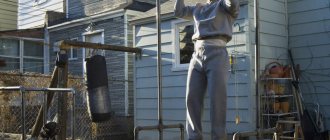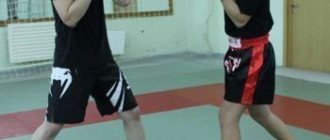Number of repetitions in the exercise[edit | edit code]
Read the main article:
How to create a training program
This article is based on the recommendations of Christian Thibadeau, a long-time weightlifter and specialist in developing training programs.
One of the factors that determines the success of any program is the correct training intensity.
Your body adapts to the loads you impose. As long as you add weight to the bar, almost any system will allow you to progress. But still, for optimal gains in mass or strength, you are better off choosing a specialized scheme, for example, for developing strength, sets of 1-3 repetitions are more effective than sets of 12-15.
Select the appropriate working ranges for each exercise from the following table.
A good fat loss program should include a variety of approaches, so specific data is not included in this table.
| Target | Exercise No. 1 (for each muscle group) | Exercise No. 2 | Exercise No. 3 (if available) | Exercise No. 4 (if available) |
| Force | Function: relative or absolute strength 1-3 reps per set 3-5 reps per set 3/2/1 wave 5/1 contrast sets 5x1 cluster sets | Function: absolute strength or functional hypertrophy 3-5 reps per set 6-8 reps per set 6/4/2 wave 7/5/3 wave | Same as in exercise No. 2 | Same as in exercise No. 2 |
| Weight | Function: functional or general hypertrophy 6-8 reps per set 8-10 reps per set 10-12 reps per set | Function: hypertrophy 8-10 reps per set 10-12 reps per set | Function: Hypertrophy or Strength Endurance 8-10 reps per set 10-12 reps per set 12-20 reps per set | Same as in exercise No. 3 |
| Relief | Varies | Varies | Varies | Varies |
CONCLUSION
How many exercises to do is up to you, but during the week all muscles should be trained at least 1 time, and lagging groups can be trained 2 times.
For 1 workout, if you train at least during the week:
– 2 times, you need to perform 7 to 8 exercises
– 3 times, you need to perform from 4 to 6 exercises
– 4-5 workouts, you need to do 2 to 4 exercises
The best option for ordinary non-professional people would be 3 workouts a day, just give it your all, and don’t come just to do a number and “scratch” your tongue.
Research data[edit | edit code]
| Study | Number of repetitions | Hypertrophy | Force | Endurance |
| Weiss et al, 2000[1][2] | 3-5 or 13-15 or 23-25 | No difference between groups | Best results at 3-5 reps, worst at 23-25 reps | Not studied |
| Campos et al, 2000[3] | 3-5 or 9-11 or 20-28 | No difference between 3-5 and 9-11, but hypertrophy is lower at 20-28 | Best result in 3-5 | Best result at 20-28 |
| Alcaraz et al, 2011[4] | twice 6, but in one group the rest is 30 s, in the other 3 minutes | No difference between groups | No difference between groups | Not studied |
| Mitchell et al, 2012[5] | 3 sets of 30% of 1RM or 3 sets of 80% of 1RM or 1 set of 80% of 1RM | No difference between groups | Best result in 80% group | The best result in the 30% group |
| Schoenfeld et al, 2014[6] | 2-4 or 8-12 | No difference between groups | Best result in 2-4 | Not studied |
| Van Roie et al, 2014[7] | 10-15 or 80-100 or 60 at 20% 1RM followed by 40% 1RM to failure | No difference between groups | The best result is in 10-15 and the third group | Only an increase of 80-100 |
| Schoenfeld et al, 2015[8] | 8-12 or 25-35 | No difference between groups | Best result at 8-12 | Best result at 25-35 |
Number of repetitions for muscle growth.
Most scientific studies have found that total hypertrophy is greater when performing low-rep training (less than 10-12 repetitions).[9]
For the low repetition (3-5) and medium repetition (9-11) groups, significant hypertrophy of both red and white fibers was observed, while the high repetition group (20-28) showed no significant changes relative to the control group. observed.
Another study[10] found that maximum muscle protein synthesis occurred when using weights of approximately 80% of the rep maximum, which corresponds to 8-12 repetitions to failure.
Number of repetitions to develop strength.
The 1RM graphs show that in the case of the “low rep” (3-5) group, strength increased significantly, the “medium rep” (9-11) group also became much stronger after training, however, still weaker than the low rep group, and even the “high rep” group (20-28) became noticeably stronger compared to the control group, although, especially in the leg press, the difference in strength between the high-rep and low-rep groups was quite significant.
How to Train for Maximum Muscle Growth
There are 3 main methods to stimulate muscle growth:
- Load progression - aimed at increasing strength and constantly increasing working weights.
- Cellular Fatigue - Metabolism in muscle cells is pushed to the limit by high repetitions. Also commonly called pumping. A very common method in bodybuilder training.
- Muscle damage - training for micro-tears of contractile fibers. Typically accompanied by muscle pain and called muscle pain (DOMs). Although muscle pain does not always mean muscle growth.
The best training method for gaining muscle mass quickly is to focus all your attention on progressive loads and muscle failure in the last sets.
Many studies have demonstrated that progressive overload is the most effective method of stimulating muscle growth.
Eg:
- 1 approach - 100 kg.
- 2nd approach - 110 kg.
- 3rd approach - 120 kg.
- 4th approach - 135 kg.
When you do 4 sets of 6 reps, the first two sets will be relatively easy for you. The third is difficult, and in the fourth you should reach muscle failure. That is, 4, 5 or 6 repetitions simply cannot be completed (or with great effort). 80% of the time in the gym it is desirable to train this way, regardless of the muscle group. Again, all this is aimed at increasing strength indicators. Strength gains are very important because they typically precede muscle growth in natural athletes. Let's give an example. In one study, 33 participants were divided into two groups:
- 4 workouts per week - four sets of 10-12 repetitions with 70% of one-rep maximum (1RM).
- 4 workouts per week - four sets of 3-5 reps with 90% of 1RM.
90% of a one-rep max is a much greater load on the muscles than 70%. And it activates a large number of fast type 2 muscle fibers . Due to this, you can lift very heavy weights. Naturally, it will not be possible to do 10-12 approaches with a very heavy weight (90% of 1RM). You'll stop at reps 2-5. The programs in both groups were composed of the following exercises: squats, deadlifts, bench presses and military presses. After 8 weeks, participants in the second group gained much more strength and gained more muscle mass. Again, it all came down to activating type 2 fast muscle fibers. It is their stimulation that determines how much muscle mass a natural athlete can gain per month. And for this there is nothing better than performing sets with heavy weights for low reps. This doesn't mean that higher rep sets are useless. The volume of such training (total number of repetitions) is usually very large. But there is no need for our body to recruit type 2 muscle fibers unless we perform sets to muscle failure. And with a large number of repetitions, type 1 fibers are trained, which are responsible for endurance. Many sports studies have proven that training strength and endurance at the same time, unfortunately, does not produce results. If you don't reach muscle failure, high-repetition sets (pump training) will only lead to the development of endurance. And if you achieve it, then it will be excessive violence against the body. Will quickly lead to overtraining. There is no chance of sufficient rest and recovery between such training sessions. Unless, of course, you take steroid drugs.
The number and speed of repetitions for the development of various physical qualities[edit | edit code]
Source: "Training Programs"
, scientific ed.
Author:
Professor, Doctor of Science Tudor Bompa, 2020
Speed, or time, of repetitions
is an important load parameter during strength training, which is not always used correctly. For example, there is a common belief in bodybuilding circles that lifting weights should be done slowly when lifting above 85 percent of your RM, but in reality this is not strictly necessary. Strength athletes who develop explosive lifting can quickly lift loads up to 95 percent of their rep max and demonstrate high levels of energy production even under such high loads.
The whole point is to train the nervous system to activate all motor units within the shortest possible period of time. This effect is achieved by periodizing the strength training program and moving from intermuscular coordination training (explosive work under moderate to high load) to intramuscular coordination training (explosive work under maximum load or at least an attempt at explosive work)[11]. See the table in the article Adaptation to physical activity.
To develop maximal strength (i.e., working at 70 to 100 percent of your rep max), the number of repetitions should be low (one to five); see table 8 in the article Gradual increase in load. For power-building exercises (i.e., working at 50 to 80 percent of your rep max), the number of repetitions should be low to moderate (one to 10 dynamic repetitions). For short-term muscular endurance, 10 to 30 repetitions are appropriate, while medium-term muscular endurance requires 30 to 60 continuous repetitions, and long-term muscular endurance requires even more repetitions of up to 200. The number of repetitions suggested may be shocking. trainers who believe that 20 repetitions is enough to develop muscular endurance. However, performing 20 repetitions has little effect on overall performance in sports that require mid- to long-term muscular endurance, such as rowing, kayaking, canoeing, long-distance swimming, and cross-country skiing.
Table 1 shows the relationship between load and possible number of repetitions performed to failure by two different types of athletes. It also follows from this table that RM conversion tables are practically useless, since they do not take into account the individual characteristics of the athlete, who may be at one of the extremes of the neuro-metabolic range.
Table 1. Correlation between percentage rep max and possible number of repetitions to failure for athletes with a neuromuscular advantage and athletes with a metabolic advantage
| An athlete with a high level of neuromuscular efficiency (power) | Athlete with a high level of metabolic efficiency (endurance) | |
| %repetition max | Repetitions | Repetitions |
| 100 | 1 | 1 |
| 95 | 1-2 | 2-3 |
| 90 | 3 | 4-5 |
| 85 | 5 | 6-8 |
| 80 | 6 | 10-12 |
| 75 | 8 | 15-20 |
| 70 | 10 | 25-30 |
| 65 | 15 | 40-50 |
| 60 | 20 | 70-90 |
| 50 | 25-30 | 90-110 |
| 40 | 40-50 | 120-150 |
| 30 | 70-100 | 150-200 |
Speed is an important factor in strength training. To achieve maximum effect, the speed of repetitions must be high and explosive for most exercises, at least for the concentric phase. Proper use of speed involves the athlete applying force against resistance. For example, when an American football player, thrower, or sprinter is working under a high load (above 90% of the rep max), the movement may appear slow, but the force being applied against the resistance is as fast as possible. Otherwise, the nervous system does not recruit and activate at maximum frequency all the motor units necessary to overcome resistance. Only through the rapid and vigorous application of force does training occur to intentionally engage the fibers of fast-twitch muscles. Strictly speaking, according to the results of recent studies that looked at performing a concentric weight lifting effort at the maximum expected speed and at half the speed, performing the lift at maximum speed for six weeks resulted in twice the increase in maximum strength compared to the increase in maximum. strength when slowly lifting weights, and the speed of work increases under any load[12].
For this reason, muscle contraction speed plays a very important role in strength training. In order to achieve explosive force, the athlete must concentrate on rapidly activating the muscles, even when the barbell is moving slowly. Although most of the time the bar should be moving quickly. Fast twitch fibers are instantly recruited only at high contraction speeds under heavy load (above 70 percent RM), resulting in increased maximal strength and power.
The timing of repetitions also has a significant impact on the physiological response during strength training, and this factor is directly related to the length of time the muscles are under tension during the set; see table 2. Accordingly, the speed of movement should vary, depending on the stage of training. Table 3 shows the repetition times for each phase of the strength training program.
At a moderate speed of the concentric phase, metabolic tension and expression of muscle force throughout the range of motion increases, and such speed can be used to enhance the hypertrophic response to training. Moderate speed is used during the anatomical adaptation phase because in this situation the athlete has better control of the movement and the muscles are under pressure for a longer period of time. The eccentric portion of the weight lift can last for three to four seconds, followed by a one-second pause to transition from the eccentric to the concentric phase, and then two seconds during the concentric phase. However, throughout the remainder of the annual plan, athletes should perform the concentric phase of strength training in a high-velocity, explosive manner, as most sports require rapid concentric contractions.
The desired contraction velocity should be as high as possible during the phases where the focus is on maximum strength, power, strength endurance and short-term muscular endurance. During the maximal strength phase, athletes should perform three to four eccentric actions slowly, followed by an explosive concentric action. At this stage, the athlete can control the transition from eccentric to concentric action. In fact, the best way to maximize concentric strength is to remove any reflex or flexibility characteristics developed during the eccentric phase of the weight lift by pausing for one to two seconds before performing the concentric phase. These techniques should be used early in the maximal strength training phase.
Table 2. Training results according to changes in repetition time
| MUSCLE ACTION | ECCENTRIC PHASE | ISOMETRIC PHASE BETWEEN ECCENTRIC AND CONCENTRIC PHASES | CONCENTRIC PHASE | ISOMETRIC PHASE BETWEEN CONCENTRIC AND ECCENTRIC PHASES | ||||
| TIME PERFORMANCE | Slow (3-5 sec.) | Fast (<1 sec.) | Absent | Present (1-5 sec.) | Slow (2-3 sec.) | Fast (<1 sec.) | Absent | Present (1-2 sec.) |
| EFFECT WORKOUT | Promotion hypertrophy | Decline hypertrophy | Decline hypertrophy | Increased hypertrophy | Promotion hypertrophy | Promotion Max. strength | Promotion metabolic voltage | Increased activation of fast twitch fibers |
| Increased max, strength | Promotion cyclical starting strength | Increased cyclic starting strength | Increased acyclic starting force | Promotion metabolic voltage | Promotion nervous voltage | |||
Table 3: Suggested rep times by stage of training
| Eccentric phase | Isometric phase between eccentric and concentric phases | Concentric phase | Isometric phase between eccentric and concentric phases | Example of suggested runtime | |
| AA | Slow | Present | Slow or fast | Absent | 3.0.2.0 |
| Hyp. | Slow | Present or absent | Fast | Absent | 4.1.1.0 |
| MS | Slow | Present or absent | Fast | Absent or present | 3.0.Х.1 |
| M | Fast | Absent (cyclic), present (acyclic) | Fast | Absent or present | 1.0.X.0 |
| NE | Fast | Absent (cyclic), present (acyclic) | Fast | Absent | 1.0.X.0 |
| CMS | Fast | Absent | Fast | Absent | 1.0.1.0 |
| SMV | Moderate | Absent | Fast | Absent | 2.0.1.0 |
| DMV | Moderate | Absent | Moderate | Absent | 2.0.1.0 |
Legend: AA - anatomical adaptation, Hyp. - hypertrophy, DMV - long-term muscular endurance, SMV - medium-term muscular endurance, CMV - short-term muscular endurance, MS - maximum strength, M - power and SV - strength endurance.
As an example, consider the bench press. When performing this exercise, the concentric part consists of extending the arms, and returning the bar to chest level and stretching the chest muscles is the eccentric part. In a simplified way, the exercise is the following sequence: the athlete slowly bends his arms to bring the barbell closer to his chest, after which he quickly returns it to its starting position and starts the cycle all over again. On the other hand, the eccentric part of the work can increase the strength of the subsequent concentric part if the eccentric part is also performed quickly, resulting in the so-called myotatic reflex. This reflex is the reason why plyometric training is especially popular in sports. Essentially, plyometric training results in improved athlete performance by improving the physiological properties of the prime mover muscles to perform fast and explosive concentric actions.
When an athlete quickly lowers the barbell to the chest, neural mechanisms in the muscles are activated and elastic energy is stored in the ligaments for use during the concentric or lifting phase of the barbell. Thus, a net increase in concentric force generation can be achieved by pausing after the eccentric phase, thereby eliminating the positive effect of the eccentric phase. This approach makes it possible to standardize the range of motion of each repetition and does not allow the athlete to cheat and push the weight. As a result, due to improved execution technique, intermuscular coordination improves.
This approach can also be used to help an athlete overcome a training plateau. The coach must determine the priority, which may be deliberate maximization of concentric strength or imitation of a specific neuromuscular algorithm (usually an action that includes an eccentric and concentric phase). Ultimately, at the stage of maximum strength, priority should be given not to the first, but to the second.
Rep time is directly related to the duration of the set and represents the interval during which the muscles are under tension during a repetition. If you multiply this period of time by the number of repetitions, you can determine the total duration of the approach. For each stage of training, there is an optimal way to perform each repetition, depending on the training effect that is the goal of that stage. This specificity also applies to the duration of the approach, which depends on the body’s energy system involved. Table 4 shows the training effect for various set durations.
Table 4. Duration of approach and training results
| Duration of approach | Training effect |
| 2-12 seconds | Increased strength without gains in hypertrophy (relative strength) or power |
| 15-25 seconds | Increased strength with increased hypertrophy (absolute strength) |
| 30-60 seconds | Hypertrophy |
| 6-15 seconds (series of approaches) 15-30 seconds (approaches) | Strength endurance |
| 15-60 seconds (series of approaches) 30-120 seconds (approaches) | Short-term muscular endurance |
| 1-4 minutes (series of approaches) 2-8 minutes (sets) | Medium-term muscular endurance |
| Over 8 minutes | Long-term muscular endurance |
How many repetitions and approaches should I do?
Let's now talk in more detail about each case of performing an approach to mass, strength, endurance or relief, but before that, let's introduce the concepts of basic terms .
Repetition (repetition) is the execution of a movement alternately in two opposite directions, that is, first in the phase of eccentric contraction (the muscle lengthens), and then in the phase of concentric contraction (shortening the muscle). And if it’s very simple, then a repetition is a one-time exercise, that is, one time .
An approach is performing without rest (without stopping) several repetitions in a row (from one and above).
How many repetitions and approaches to do
Set time is the time it takes to complete repetitions in one set.
For strength (increasing strength indicators)
One of the main tasks and goals of many athletes in various sports is to increase strength indicators, which are often the prevailing factor in victory in speed-strength sports. For example, if you are a sprinter , then strength indicators are more important to you, and if you are a stayer , then endurance, based on this you need to build your training process.
In bodybuilding , approaches to increase muscle mass also increase strength, but not at all as pronounced as if you were performing an approach with an emphasis on increasing strength indicators.
Training for strength means performing an exercise for a small number of repetitions from 1 to 5 times , in this given number of repetitions the muscles will be under load for about 2-25 seconds , which means active consumption of creatine (remember the energy supply of muscle activity) and training of fast muscle fibers (myofibrillar hypertrophy).
Accordingly, the more intense the training, the more and faster creatine is consumed in the body. That is why if your goal is to increase strength, then it is advisable to combine your training with taking creatine supplements.
Perform strength approaches
Creatine is a natural compound formed in the body from three amino acids (methionine, arginine and glycine), which is involved in energy metabolism and is consumed in large quantities during active physical work for a maximum of the first 2 minutes , then other energy sources (glycogen, fats) are connected.
Thus, strength training - with a small number of repetitions in approaches, actively stimulates the growth of contractile proteins (the main ones are myosin, actin, actomyosin, tropomyosin, troponin, b- and b-actinins)
When training, it is important to select such a weight on the bar/simulator so that you enter a given range of the number of repetitions, in this case from one to five, that is, after the fifth repetition you should experience failure (or almost muscle failure). If, for example, you did 5 repetitions and finished the set, but you yourself feel that you could still do 3-4 repetitions from above, then increase the working weight - you should have enough strength for clearly 5 repetitions (or less if you do 2 -4). Otherwise, your training cannot be considered full-fledged for strength, but rather for mass with an underload .
For mass (increasing muscle volume)
Approaches performed for mass in bodybuilding must lie strictly within the range
8-12 reps , which corresponds to approximately 80% of your maximum weight lifted in the exercise. It is with this type of training that strength exercises can bring you significant success in hypertrophy (increase) muscle mass.
8-12 rep sets are very popular in gyms among bodybuilders, and for good reason. A very long time ago, when experiments had not yet been carried out on the effectiveness of one or another training option, bodybuilders found out empirically that the 8-12 repetition range grows muscles very well (for example, remember the words of Tom Platz, who, responding at his seminar , said that many things in He learned about bodybuilding through experience, and only then read studies that confirmed his effective training). This happened with the number of repetitions, Tom Platz came to the conclusion: 8-12 repetitions best increase muscle mass, but only later these data were confirmed by scientists (link to one of the studies in 2008 https://physoc.onlinelibrary.wiley.com /doi/full/10.1113/jphysiol.2008.164483, which states that protein synthesis in the body occurs most actively when an athlete trains with 80% of his maximum working weights, which equals 8-12 repetitions of the exercises.)
So, it is worth keeping in mind that if strength training increases the amount of contractile protein, then mass training increases the amount of non-contractile protein, that is, increased time under physical activity activates sarcoplasmic hypertrophy.
Thus, performing the exercise 8-12 times (average number of repetitions) maintains a balance between sarcoplasmic and myofibrillar hypertrophy, which has the best effect on increasing muscle mass, that is, this training option is ideal for bodybuilders.
Performing approaches to increase muscle mass
The optimal time during which a strength (anaerobic) exercise is performed in one approach to weight will be 30-60 seconds .
In addition, do not forget that when an athlete trains for weight, the most important supplement for him will be not only creatine, but also protein - the use of high-quality amino acids, which can be taken, for example, from whey protein .
For relief (increasing muscle dryness)
Before moving on to the description of training principles for muscle relief, I would like to tell you that dryness and its separation are determined not by training at all, but by the percentage of fat in the body. Therefore, as you probably already guessed, the less fat you have, the more prominent you will look and it doesn’t matter at all what kind of training you do.
to nutrition alone , you just need to know that proper nutrition is the most important factor when it comes to muscle definition. In addition, you can, of course, lose weight on a diet , but without training you won’t even muscle tone . Therefore, it is important to choose the right training option based on your current physique. Accordingly, it will be much easier mesomorphs for endomorphs .
So, for example, if you already have impressive amounts of muscle mass, and just want to dry out your muscles, then we recommend that, firstly, shift your diet towards a calorie deficit , and secondly, include cardio training , which will not only make it more effective burn fat, but also strengthen the cardiovascular system. If you are obese and suddenly want to dry out your muscles, then any training will be of little effectiveness, in this case you need to urgently change your diet and in every possible way speed up your metabolism by including only aerobic exercises .
Performing muscle relief approaches
And now that you already know the intricacies of muscle relief, you can move on to describing the construction of training principles for drying muscles.
How to structure your workouts and how many repetitions to do to tone your muscles?
Once you have decided on your body type and current physical fitness, you can move on to choosing workouts:
- Standard strength training + cardio + diet changes
- High-intensity training with low rest and high repetitions + changing the menu towards a calorie deficit + aerobic (cardio) exercise
As mentioned above, for more effective fat burning , we recommend that you include aerobic exercises (running, jumping, jumping rope, exercise bike, etc.) in your training program and naturally reduce calorie intake, mainly by giving up fast carbohydrates (flour, sweets, soda , white rice, fast food, chips, etc.). For those interested, we discussed nutritional options for drying muscles in detail in this article.
The number of repetitions, in the first option (when we don’t change strength training), we keep the training at 8-12 = the optimal range for maximum muscle growth, but at the same time we definitely reduce the calorie intake (cut carbohydrates, add proteins) and add cardio training , for example, three running workouts of 40 -50 minutes at a pulse of 120-130 beats .
How much does it cost to train for muscle definition?
In the second training option, we bring the repetition range to 15 , and the number of approaches to 5-6 , thereby we force the muscles to work as energetically as possible, and accordingly, fat “burns” faster. However, we do not recommend performing more than 15 repetitions on relief, since in this case muscle hypertrophy , that is, the more repetitions you do, the less weight you will have to put on the bar/simulator, which means the muscles will receive less load . and as you already know, the range of 8-12 maximizes muscle growth, so the further we move away from it, the worse it is for muscle hypertrophy.
In addition, you must remember that it is impossible to dry muscles and increase their size at the same time. Yes, of course, during training and after it, the processes of catabolism (destruction) and anabolism (growth) of muscle mass are constantly going on, and when the second process wins, we can talk about hypertrophy, and when it loses to the first process (catabolism), we talk about muscle destruction /fat. Everything would be fine if the processes of anabolism were not associated with weight gain , and naturally, along with muscles, a person will gain fat (of course, it can be minimized, but it will be gained), so the most correct decision will be for all “jocks” who want to have large, defined muscles - first gain weight, and then dry it out, with the help of:
- high intensity strength training
- cardio exercises
- proper nutrition (creating a calorie deficit)
Without these three components (especially the last two!) in your training process, no matter how many repetitions you do in the exercises, you will not see sculpted muscles.
Cardio for muscle relief
Thus, if you want to quickly lose weight despite significant muscle loss, then choose high-intensity exercises, cardio and a calorie deficit; if maintaining muscle mass is important to you, then choose slow, gradual fat burning through moderate strength training (we accelerate the metabolism ), cardio and calorie deficit. That is, between the first and second options there will be a fundamental difference in the intensity and choice of exercises performed (in the first case there are more high-intensity, high-repetition exercises with a range of 10-15 repetitions and involving cardio, in the second case there are more basic strength exercises with a range of 8-12 repetitions) .
For muscle endurance
The number of repetitions in endurance exercises should be many (15-20) , in addition, we must not forget that endurance varies, it is one thing when we are talking about strength endurance, another thing when it comes to monotonous, high-intensity aerobic exercise (long-distance swimming , long distance running, cross country and so on).
In this article we will dwell in detail on speed-strength endurance, because this is what most often interests athletes who visit the gym.
To put it very simply, strength endurance is the ability to perform intense work (show great strength) for a long time. For example, a sprinter in running or swimming will train sprinting qualities by constructing his training program in a certain way to develop speed-strength endurance; in bodybuilding pump approaches (performing a large number of repetitions with a small weight) .
As you already know from our other articles, the main supplier of ATP (energy) in the gym during exercise is creatine in the form of creatine phosphate and glycogen , and so thanks to biochemical reactions during the breakdown of creatine phosphate and carbohydrates (in the form of glycogen) along the path of anaerobic glycolysis (without participation of oxygen with the release of lactate) energy is produced. Moreover, the slower the consumption of creatine and glycogen and the faster the utilization of lactic acid (lactate), the more enduring the athlete will be; in addition, we must not forget that endurance training actively trains red, slow muscle fibers, which also thicken over time, actively growing capillary network, increase the number of mitochondria , as well as the ability to store glycogen, all this ultimately leads to the so-called sarcoplasmic hypertrophy of muscle fiber.
Circuit training to develop endurance
The best option for developing speed-strength endurance is still considered to be circuit training options , which involve performing a large number of repetitions and approaches with a short rest interval.
For example, a typical circuit training:
- pull-ups on the bar 30 sec.
- barbell squats 30 sec.
- biceps curl 30 sec.
- bench press 45 sec.
- static hold of the barbell while lying on a bench (pull your arms to your chest) for 30 sec.
The working weight in the approaches should be below average , approximately 50-60% of the maximum, the number of repetitions you perform in one session is as many . As soon as you finish the first circle, rest for 2-3 minutes, start the second, and so on up to 5 circles .
Strength exercises can be replaced with aerobic , then you will already be training aerobic endurance, something that is so necessary for many wrestlers, swimmers, boxers, and so on.
You may be interested, but each new kilogram of muscle mass requires additional oxygen (on average 0.2-0.3 l/minute), therefore, other things being equal, those who have less muscle will have more endurance.
Read also[edit | edit code]
- How many repetitions to do in a set - scientific data
- Number of approaches per muscle group
- Gradual increase in load
- Training Volume
- Strength Training Intensity
- Rest between exercises and sets
- How many approaches to do
- Rest between sets
- How often to exercise
- Order of exercises
- The best exercises for gaining muscle mass
- We work on the relief
- Terrain training
BASIC AND ISOLATION EXERCISES
The number of exercises in training depends on the complexity of the exercises; if preference is given to basic exercises, then a large number of muscles are involved in the work, they get more tired and after hard performance of 2-3 basic exercises, there is practically no strength left for isolated ones.
If a person is lazy to make a base and chooses isolated exercises for training, then their number increases. For beginners, men will do 5-6 exercises optimally, and for women 7-8 exercises per workout, since women have fewer basic exercises.
Sources[edit | edit code]
- Weiss, LW, Coney HD, Clark FC. Gross measures of exercise-induced muscular hypertrophy. J Orthop Sports Phys Ther. 2000;30(3):143-148.
- Weiss LW, Coney HD, Clark FC. Differential functional adaptations to short-term low-, moderate-, and high-repetition weight training. J Strength Cond Res. 1999;13(3):236-241.
- Campos GE, Luecke TJ, Wendeln HK, Toma K, Hagerman FC, Murray TF, Ragg KE, Ratamess NA, Kraemer WJ, Staron RS. Muscular adaptations in response to three different resistance-training regimens: specificity of repetition maximum training zones. Eur J Appl Physiol. 2002;88:50-60.
- Alcaraz PE, Gomze PJ, Chavarrias M, Blazevich AJ. Similarity in adaptations to high-resistance circuit vs. traditional strength training in resistance-trained men. J Strength Cond Res. 2011;25(9):2519-27.
- Mitchell CJ, Churchward-Venne TA, West DW, Burd NA, Breen L, Baker SK, Phillips SM. Resistance exercise load does not determine training-mediated hypertrophic gains in young men. J Appl Physiol. 2012;113:71-77.
- Schoenfeld BJ, Ratamess NA, Peterson MD, Contreras B, Sonmez GT, Alvar BA. Effects of different volume-equated resistance training loading strategies on muscular adaptations in well-trained men. J Strength Cond Res. 2014;28(10):2909-18.
- Van Roie E, Delecluse C, Coudyzer W, Boonen S, Bautmans I. Strength training at high versus low external resistance in older adults: effects on muscle volume, muscle strength, and force-velocity characteristics. Exp Gerontol. 2013;48(11):1351-61
- Schoenfeld BJ, Peterson MD, Ogborn D, Contreras B, Sonmez GT. Effects of Low-Versus High-Load Resistance Training on Muscle Strength and Hypertrophy in Well-Trained Men. J Strength Cond Res. 2015.
- “Muscular adaptations in response to three different resistance-training regimens: specificity of repetition maximum training zones” Eur J Appl Physiol (2002) 88: 50–60
- https://onlinelibrary.wiley.com/doi/10.1113/jphysiol.2008.164483/abstract
- Behm, D., and Sale, DG 1993. Intended rather than actual movement velocity determines velocity-specific training response. Journal of Applied Physiology 74:359–68.
- Gonzalez-Badillo, JJ, et al. 2014. Maximal intended velocity training induces greater gains in bench press performance than deliberately slower half-velocity training, Eur J Sport Sci. 15:1-10.










